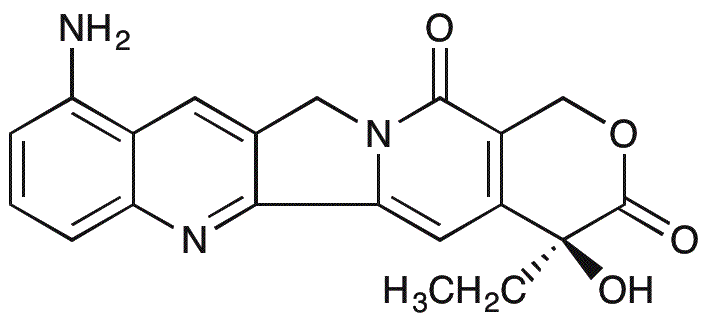9-Aminocamptothecin is widely utilized in research focused on:
- Cancer Treatment: This compound is a potent topoisomerase I inhibitor, making it a valuable candidate in developing therapies for various cancers, particularly colorectal and ovarian cancers.
- Pharmaceutical Development: It serves as a lead compound in the synthesis of new anticancer agents, allowing researchers to modify its structure to enhance efficacy and reduce side effects.
- Drug Combination Studies: Researchers often explore its effectiveness in combination with other chemotherapeutic agents, aiming to improve treatment outcomes and overcome drug resistance in cancer cells.
- Biological Research: The compound is used in studies to understand the mechanisms of DNA damage and repair, providing insights into cancer biology and potential therapeutic targets.
- Formulation Science: Its properties are investigated for developing novel drug delivery systems, enhancing the solubility and bioavailability of anticancer drugs.
General Information
Properties
Safety and Regulations
Applications
9-Aminocamptothecin is widely utilized in research focused on:
- Cancer Treatment: This compound is a potent topoisomerase I inhibitor, making it a valuable candidate in developing therapies for various cancers, particularly colorectal and ovarian cancers.
- Pharmaceutical Development: It serves as a lead compound in the synthesis of new anticancer agents, allowing researchers to modify its structure to enhance efficacy and reduce side effects.
- Drug Combination Studies: Researchers often explore its effectiveness in combination with other chemotherapeutic agents, aiming to improve treatment outcomes and overcome drug resistance in cancer cells.
- Biological Research: The compound is used in studies to understand the mechanisms of DNA damage and repair, providing insights into cancer biology and potential therapeutic targets.
- Formulation Science: Its properties are investigated for developing novel drug delivery systems, enhancing the solubility and bioavailability of anticancer drugs.
Documents
Safety Data Sheets (SDS)
The SDS provides comprehensive safety information on handling, storage, and disposal of the product.
Product Specification (PS)
The PS provides a comprehensive breakdown of the product’s properties, including chemical composition, physical state, purity, and storage requirements. It also details acceptable quality ranges and the product's intended applications.
Certificates of Analysis (COA)
Search for Certificates of Analysis (COA) by entering the products Lot Number. Lot and Batch Numbers can be found on a product’s label following the words ‘Lot’ or ‘Batch’.
Numéro de catalogue
Numéro de lot/série
Certificates Of Origin (COO)
This COO confirms the country where the product was manufactured, and also details the materials and components used in it and whether it is derived from natural, synthetic, or other specific sources. This certificate may be required for customs, trade, and regulatory compliance.
Numéro de catalogue
Numéro de lot/série
Safety Data Sheets (SDS)
The SDS provides comprehensive safety information on handling, storage, and disposal of the product.
DownloadProduct Specification (PS)
The PS provides a comprehensive breakdown of the product’s properties, including chemical composition, physical state, purity, and storage requirements. It also details acceptable quality ranges and the product's intended applications.
DownloadCertificates of Analysis (COA)
Search for Certificates of Analysis (COA) by entering the products Lot Number. Lot and Batch Numbers can be found on a product’s label following the words ‘Lot’ or ‘Batch’.
Numéro de catalogue
Numéro de lot/série
Certificates Of Origin (COO)
This COO confirms the country where the product was manufactured, and also details the materials and components used in it and whether it is derived from natural, synthetic, or other specific sources. This certificate may be required for customs, trade, and regulatory compliance.


